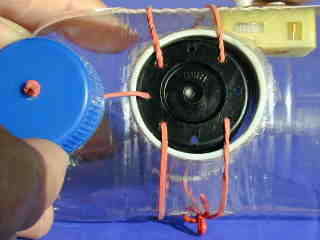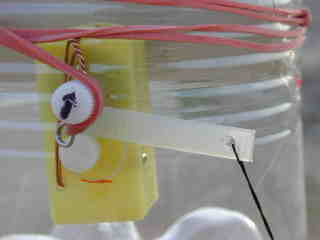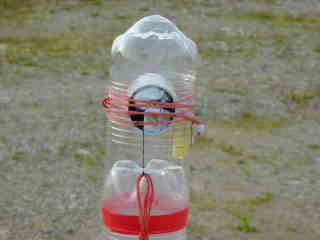HDTT: Horizontal chute Deployment with Tomy Timer
After having wasted several rockets with the well-known lawn-dart method, it was obvious that the next project had to be a reliable chute deployment. I have thought about several methods including electronics using 555 timer circuits in combination with a mercury switch. But, fortunately before entering the manufacturing stage, I realized (with the help of the discussions in the WR mailing list) that the mercury switch can not switch reliably at apogee.
So what to do? Robert Youen came up
with the idea of horizontal deployment which I really liked. After a successful
long hunt in the toy shops of my town I was lucky to get hold of a toy
with a Tomy timer, which was quickly disassembled.
More on Tomy timers here (recommended reading).
Note: in the meantime Robert perfected the construction of HDTT for FTC based rockets. Visit his site with his amazing rockets.
My own setup, which was built on 14. Sept 2000 is viewed best on these pictures:
 |
The timer, rigged to a guppy-nosed 0.5 liter Fanta bottle, using the existing holes in the timer. |
 |
The pvc pipe holding the plunger and the chute. |
 |
The plunger, made of a film can. Note the end, cut to the inner shape of the bottle. A bottle cap is added as a pusher (for small chutes only). |
 |
The plunger, assembled in the chute pipe. |
 |
My rocket CP1 in the field, ready for chute stuffing. The chute assembly is modular, its bottom end was expanded sightly so that it fits snugly onto the top of the main rocket body. It is fixed there with red tape. |
 |
Detail of the timer release, set to about 2.7 sec. The timer was having an excenter which I could use easily as an "ignition switch" – a piece of a white cable tie is jammed between the main shaft and the excenter, inhibiting the timer to run. The black string is tied down to the launcher, pulling the cable tie piece away at launch. |
 |
The chute, stuffed in and fixed through a rubber band. Note the thin black thread above the red quadruple rubber shock absorber on the bottom. It was way too weak! Read the Launch report to see the outcome. |
 |
After the unhappy landing it was clear that the shock cord had to be improved. Searching around in the house, I found two types of material in the sewing basket of my wife: rubber cord, usually used for underwear. The regular one (left, 6.5 mm wide) is inferior; the right one (5 mm wide) is intended for baby pants, "especially soft" but still very strong, and stretches 4 times its length, the former only 2.5 times. |
 |
To fasten the shock cord to the fin side of the rocket, I use 2 pieces of tape: the left one to anchor the chute cord to the rocket; the right one to give it a definite direction towards the chute compartment in the nose; this one may (partly) rip off at deployment, because it will suffer peeling forces, but so far it did not. The actual chute cord (white, left) is looped into the nylon anchor string. |
![]()














